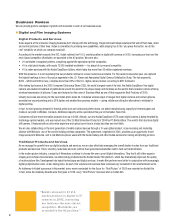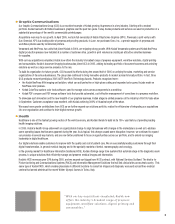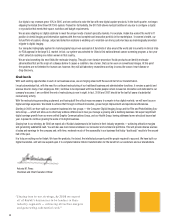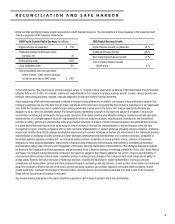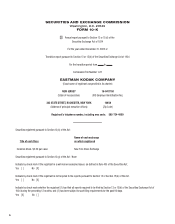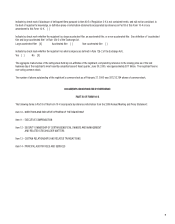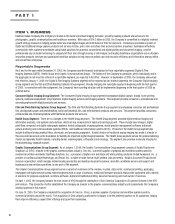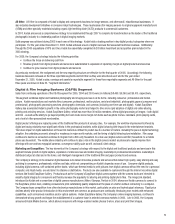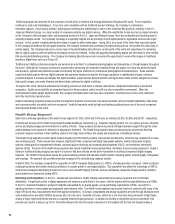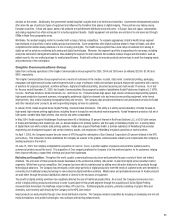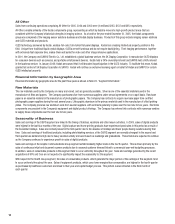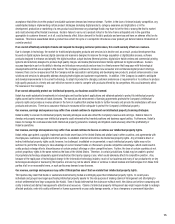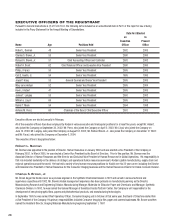Kodak 2005 Annual Report Download - page 14
Download and view the complete annual report
Please find page 14 of the 2005 Kodak annual report below. You can navigate through the pages in the report by either clicking on the pages listed below, or by using the keyword search tool below to find specific information within the annual report.12
All Other
Sales from continuing operations comprising All Other for 2005, 2004 and 2003 were (in millions) $163, $122 and $96, respectively.
All Other consists primarily of the Kodak components group, representing an effort by Kodak’s move into high-growth product areas that are
consistent with the Company’s historical strengths in imaging science. As of and for the year ended December 31, 2005, the Kodak components
group was comprised of the imaging sensor solutions business and Kodak display business. Products of this group include imaging sensor solutions
and OLED materials and products.
OLED technology, pioneered by Kodak, enables full-color, full-motion fl at-panel displays. Kodak has a leading intellectual property position in this
fi eld. Unique from traditional liquid crystal displays, OLEDs are self-luminous and do not require backlighting. Their imaging performance, together
with extremely fast response time, makes them well suited for video and other image intensive applications.
In 2001, the Company and SANYO Electric Co., Ltd. established a global business venture, the SK Display Corporation, to manufacture OLED displays
for consumer devices such as cameras, and portable entertainment devices. Kodak held a 34% ownership interest and SANYO held a 66% interest
in the business venture. In January 2006, Kodak announced that it will broaden its participation in the OLED industry. To facilitate this move, Kodak
granted full control of SK Display Corporation to SANYO. Kodak will continue as exclusive licensing agent on behalf of Kodak and SANYO for certain
OLED intellectual property.
Financial Information by Geographic Area
Financial information by geographic area for the past three years is shown in Note 23, “Segment Information.”
Raw Materials
The raw materials used by the Company are many and varied, and are generally available. Silver is one of the essential materials used in the
manufacture of fi lms and papers. The Company purchases silver from numerous suppliers under annual agreements or on a spot basis. Raw base
paper is an essential material in the manufacture of photographic papers. The Company has contracts to acquire raw base paper from certifi ed
photographic paper suppliers during the next several years. Lithographic aluminum is the primary material used in the manufacture of offset printing
plates. The Company procures raw aluminum coils from several suppliers, with contracts generally in place over the next one to two years. Electronic
components are prevalent in the Company’s equipment and digital product offerings. The Company has entered into contracts with numerous vendors
to supply these components over the next one to two years.
Seasonality of Business
Sales and earnings of the D&FIS segment are linked to the timing of holidays, vacations and other leisure activities. In 2005, sales of digital products
were highest in the last four months of the year. Digital capture and home printing products have experienced peak sales in this period as a result of
the December holidays. Sales are normally lowest in the fi rst quarter due to the absence of holidays and fewer people taking vacations during that
time. Sales and earnings of traditional products, including photofi nishing services, of the D&FIS segment are normally strongest in the second and
third quarters as demand is high due to heavy vacation activity and events such as weddings and graduations. These trends are expected to continue
as the Company continues to experience growth in sales of digital products.
Sales and earnings of the Graphic Communications Group segment exhibit modestly higher levels in the fourth quarter. This is driven primarily by the
sales of continuous inkjet and document scanner products due to seasonal customer demand linked to commercial year-end budgeting processes.
In addition, sales of consumable products in this segment tend to occur uniformly throughout the year. Sales and earnings generated by the recent
acquisitions of KPG and Creo are not expected to signifi cantly impact the seasonality for this segment.
With respect to the Health Group segment, the sales of consumable products, which generate the major portion of the earnings of this segment, tend
to occur uniformly throughout the year. Sales of equipment products, which carry lower margins than consumables, are highest in the fourth quarter
as purchases by healthcare customers are linked to their year-end capital budget process. This pattern is also refl ected in the third month of
each quarter.


